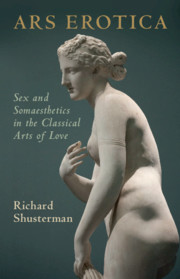Book contents
- Ars Erotica
- Ars Erotica
- Copyright page
- Dedication
- Contents
- Preface
- Abbreviations
- 1 Ars Erotica and the Question of Aesthetics
- 2 Dialectics of Desire and Virtue
- 3 The Biblical Tradition
- 4 Chinese Qi Erotics
- 5 Lovemaking as Aesthetic Education
- 6 Fragrance, Veils, and Violence
- 7 From Romantic Refinement to Courtesan Connoisseurship
- 8 Commingling, Complexity, and Conflict
- Bibliography
- Index
6 - Fragrance, Veils, and Violence
Ars Erotica in Islamic Culture
Published online by Cambridge University Press: 19 March 2021
- Ars Erotica
- Ars Erotica
- Copyright page
- Dedication
- Contents
- Preface
- Abbreviations
- 1 Ars Erotica and the Question of Aesthetics
- 2 Dialectics of Desire and Virtue
- 3 The Biblical Tradition
- 4 Chinese Qi Erotics
- 5 Lovemaking as Aesthetic Education
- 6 Fragrance, Veils, and Violence
- 7 From Romantic Refinement to Courtesan Connoisseurship
- 8 Commingling, Complexity, and Conflict
- Bibliography
- Index
Summary
This chapter examines the erotic theories of classical Islamic culture. While this culture differs greatly from that of pre-modern Japan, examined in the next chapter, they nevertheless share a distinctive feature. Both are significantly derivative cultures. As Islamic culture built heavily on Jewish, Christian, Greek, Persian, and Indian traditions, so Japan borrowed extensively from Chinese culture, not only its form of writing and its arts but also its distinctive Zen version of Buddhism, derived from China’s Chan Buddhist tradition. Both cultures, moreover, postdate the famous “axial age” that essentially defined Western, Indian, and Chinese thought. Coined by Karl Jaspers (perhaps building on the work of Max Weber), the notion of the axial age defines a period stretching from 800 to 200 BCE that encompasses the founding thinkers of Western and Asian civilizations. These include Socrates, Plato, and Aristotle in Greece, the Hebrew prophets in Israel, Zarathustra in Persia, the Buddha and the writers of the Upanishads in India, and, in China, Confucius, Mozi, the legendary Laozi, and Zhuangzi.1 Key to the axial age was a sense of the crumbling of old ideas and their replacement by a new form of thinking that posited an ideal transcendental order beyond the ordinary mundane world and affirmed the active role of intellectual elites to reshape the world in terms of that transcendental vision. As the birth of Islam and the burgeoning of Japanese culture both postdate the axial age, so their erotic theories display their belated, derivative status.
- Type
- Chapter
- Information
- Ars EroticaSex and Somaesthetics in the Classical Arts of Love, pp. 250 - 287Publisher: Cambridge University PressPrint publication year: 2021



